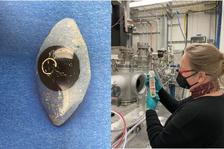The glass eye before measurement and setup of the experiment by DESY scientist Manuela Borchert. (Images: DESY, Katrin Zerbe)
The Battle of the Teutoburg Forest was a famous event in Roman antiquity. In AD 9, a Germanic army led by the legendary Arminius destroyed several Roman legions, halting the Roman advance into what was then Germania. Archaeological excavations at Kalkriese bear witness to this battle against Varus’s troops and have unearthed, among other things, bones, Roman militaria and coins as well as, most recently, an almost completely preserved set of the armour worn by legionaries. The remarkable items found on the battlefield also include six small glass eyes, each barely larger than a fingertip, some of them blue, others black.
These were recently examined at DESY using high-intensity X-rays from PETRA III to find out exactly what materials the Romans mixed into the glass during its manufacture to achieve the colours. These initial investigations recorded the fluorescence and absorption spectra to find clues about the substances that lend the eyes their colour. They allow conclusions to be drawn as to the actual pigments responsible for the colouring. Black, for example, seems to have been produced by using a higher iron content, white used more copper, and blue contained surprising amounts of lead and zinc. The Kalkriese Museum plans to continue its cooperation with DESY at PETRA III: among other things, special X-ray methods are to be used to reveal the images once stamped on now completely corroded coins, and to analyse the corrosion processes inside an iron neck shackle.
Analytical methods that rely on synchrotron radiation sources, in particular micro-imaging methods, are ideally suited for studying cultural artefacts. These non-destructive methods provide more detailed insights into the molecular structure and the composition of materials, or how they are arranged. All this information furnishes archaeologists with information and insights into how and where individual artefacts were made. Investigating the processes that occur during corrosion, for example, also allows museums and curators to better preserve precious and unique cultural artefacts.
(from DESY News)






